#very interesting details overall and i wonder how many are deliberate hints to something important
Text
The Veil and the history of the universe
I've been thinking about some connections between certain very specific concepts for a while now and mostly about how they relate to what we know about the Veil. It started with wondering about the reason for Lightfall's Collector's Edition books to bring back the concept of the OXA Machine and give us extra knowledge about it.
From there, it spiralled into more similar concepts that connect other prediction technologies, the Vex, the Darkness and most importantly how Maya Sundaresh seems to be involved with all of them. There's a lot of little details in a lot of different places about this (as well as from different times of Destiny, including one very interesting one from vanilla D1).
It's not really a theory or an attempt to solve everything, but more like an interesting dive into some possible overall connections between concepts that tend to repeat, most of which are tied to the new discoveries about the Darkness; how it's connected to the psychic aspects like memory, fear, pain and so on.
Contents:
The OXA Machine and the Psions
Inspiral raid lore book
The Device of the Future War Cult and Maya Sundaresh
The Veil
Since my line of thinking started with OXA, I will also start with the OXA here.
The OXA
What is the OXA Machine? Originally mentioned in the Collector's Edition booklet for Destiny 2 which is about Calus recounting his conquests and all of the actors that betrayed him in the Midnight Coup, the OXA is a "clairvoyant Psion machine." It's assumed the Psions made it and it was destroyed when the Psions were conquered by the Uluran. However, years later, a Psion scientist called Otzot rebuilt it and this time, Calus ordered for it to be captured and used. He also freed Otzot so she was known as "Freeborn Otzot." She joined the coup against him because he wanted to free all Psions and she feared that would ruin her unique position as the only free Psion.
It was also mentioned by the Psion Match, who wrote the entries in the lore book Confessions. Match was a councilor to Calus during his exile and wrote many entries on Calus' descent into what we know him as. Match writes the following (and gives it a possibility that the Psions simply inherited this machine and didn't make it originally):
Now I think of the OXA Machine, eternally lost and eternally rebuilt, passed down from civilization to civilization like a ship's black box.
This was a fairly vague concept, but we can easily figure out what this thing was: it's a machine used for storing information and prediction, much like any other in the Destiny universe. It wasn't used much as anything other than background flavour and you may know it from the strike Insight Terminus which mentions the OXA and Otzot in the dialogue at the end of the strike. We'll get to that a bit later.
For some reason, OXA was returned with extra details in Lightfall's Collector's Edition. It massively expands what the OXA is and gives the full description of what the acronym means. Page 13 in this transcript (chapter named "I am thirty-five years old" in Caiatl's book):
"The Odyle Xenotaph Anarchive. Sometimes OXTA, depending on how you construct the acronym. The alien oracle that led us to the graves of Aark." Must be wary, now. OXA is a Psion myth, and the Psions are a sensitive topic. My father wants to free them from bondage. "It claimed to record the story of the galaxy, and to prophesize what may yet come."
"A black box for galactic civilizations, if you prefer it in pilor's terms.” The Evocate-General nods to the pin on my right pauldron. I am conscious of my shaved-down tusks, of the sores left by the fighter's interface. "The doomed and the damned left the record of their downfall in the OXA."
The full name - Odyle Xenotaph Anarchive - isn't random gibberish. The odyle is a reference to the Odic force. This force (od, odyl or odyle) was thought to be responsible for some natural phenomena like magnetism, hypnotism, electricity or light. It was primarily tied to the human nervous system and relied on people's natural psychic sensitivity to perceive it or feel it. In this context it's most likely being used to represent some form of mental/psychic way of being influenced by or using this machine. In order to access it, one must have psychic abilities to access the source of this primordial source, like the Psions, who made (?) and remade it.
A xenotaph is most likely a play on the word cenotaph; a cenotaph is a symbolic grave built for someone or multiple people when there are no actual remains to bury. Literally, it's an "empty tomb." Here, the term swapped to "xeno" to indicate "alien." A xenotaph most likely means that it's a tomb of alien cultures which is also explained in the full definition given to Caiatl: it is literally a recording of dead alien civilisations. Similarly to a cenotaph, it's also technically an empty tomb; it's not direct remains of these civilisations, just a record of them.
An anarchive is a really tough concept to explain, but basically where the archive is simply a collection of information, an anarchive is the process of engaging, analysing and changing of the archival information for new and future purposes. This is possibly where the predictive aspect of the OXA comes in; the OXA holds information of the past civilisations, requires a powerful psychic to access and allows them to engage with this archive and come out with new information about the future, "prophesising what may yet come."
So in conclusion, the OXA is a psychic link to the history of the universe which allows those with special abilities to not only access this information, but also engage with it and learn of possible future events.
Why add this information for Lightfall? The OXA has always been more of a curiosity of an alien culture, not some sort of a major plot point. But when they take a past curiosity and add new information to it, much like with Nezarec, it may signify some sort of importance in the future.
As I mentioned earlier, pretty much the only time OXA was mentioned directly in game was in Insight Terminus strike. The Vex had information about the OXA and the Psion Kargen was trying to access it through the Vex. Two different lines at the end of the strike mentioning OXA:
Hmm, there’s only one data artifact here, labelled “OXA,” and it’s seriously corrupted. Metadata says it was last accessed by an “Otzot” centuries ago.
And:
There’s an almost unreadable data artifact here, labelled “OXA.” It’s heavily corrupted, but I’m able to make out “MSund12” from the access log.
The Vex records show that the OXA was last accessed by Otzot, but that it was also accessed by MSund12. This is Maya Sundaresh. So in one go we have a link between the Vex, the Psions and Maya Sundaresh who was a Golden Age scientist. They were all aware of and able to access the OXA.
There's one more Psion that mentions the OXA, in the Sisters weblore which is from Season of Dawn and relates to the Psion sisters that hijacked Osiris' Sundial. When they discovered the Sundial and inspected it, they were happy to find a machine that allowed to manipulate time and offer predictions. One of the sisters, Tazaroc, compared the Sundial to the OXA, but noted that the Sundial was better:
“It is so clear,” said Niruul, reverent. “An unobstructed glimpse into what was and what will be.”
“Not the troubled ramblings of a mad thing, like the OXA,” said Tazaroc.
Tazaroc considers the OXA to be "a mad thing" and that it only offered "troubled ramblings." The Sundial is far superior in its design somehow, but it's important to ask the following: do the Sundial and the OXA tap into the same (or at least similar) source? Are there other similarities between the two besides just the ability to look through time?
What should we take from this section? There is a great repository of knowledge and information about the history of the universe and the species that inhabited it which is stored and documented somewhere and it is possible to access and interact with it. The OXA is one example of this as presented through Psions and how they utilised it.
Inspiral
The lore book for Root of Nightmares raid is a curious one. The whole concept is that each entry in this book (10 total) is a record of the past that left an imprint of itself... somewhere. Each entry begins with a description of who left this information and how.
The first entry is immediately relevant here. It starts with a description of the recording:

It most definitely fits the feel of there being some sort of "black box for galactic civilisations" where data fragments are left to "mark their passing." This first entry is about the Ecumene, an alien conglomerate of species that united together to form the Ecumene itself. They are also extensively documented in the Books of Sorrow, as the Hive have came across them and wiped them out.
In this lore tab, we learn a little bit more about them. Their space was called the Habitable World and it consisted of a lot of different species joined together in the Ecumene through the power of the Deep. Aka the Darkness. This is interesting because we'd always think that any species alligned with the Darkness would be evil, like the Hive. Hell, the Hive themselves wiped out the Ecumene, despite essentially being tied to the same force. But obviously, now we know that the Darkness is not a uniformed force. It too has factions and different types of use.
The Ecumene were specialised in using the psychic aspect of the Darkness. The first entry, The Habitable World reads (still not on Ishtar and I will omit the big screenshots and just paste the text):
Meanwhile our Habitable World always grew. We offered the Fathomless Deep to any who wished to learn of our synergy, and it glossed the way to become more than we were.
And:
A new client-species drank of the Deep and understood the World as we tasted it.
And:
In the Deep may we be kept.
The third entry in the raid lore book, The Art of Symbiosis, is similarly interesting. It's a memory of the alien species called Qugu, also attacked and wiped out by the Hive. The title of the chapter refers to what we know of the Qugu from the Books of Sorrow; they are a species bound in symbiosis with another life form that they need to live. It begins with:

The Qugu were able to enter some form of altered state of consciousness known as "night-trances" to access past memories. This is noted by them to be an ability related to the Darkness.
I still hear from our parents, from our great-parents, distantly in my night-trances. And there are those nectar-made moments -- you know the ones, when you turn your thoughts to the Darkness and just listen, and the long sum of Qugu history graven there reflects dark-comforting advice.
And:
I have lived out my life with the tenebrous warmth of our ancestors over me like a (cloak/atmosphere?) between us and nothingness.
And:
I miss you. Funny, isn't it? How can you miss someone when you know they're always in the Dark? I close my eyes, and in the warm nest-hide of sleep, I know you are real and happy and out there on some other part of the world, far from the river, far from the [untranslatable] where our ancestors (dream/exist) together.
Both of these species had a connection with Darkness that was built exclusively on the aspect of the mental which is the domain of Darkness. As explained by Osiris in Lightfall, the Light is the domain of the physical, while the Darkness is the domain of the psychic, the mental. Darkness controls fear and pain and thought and memory. These species utilised their knowledge of the Darkness to form entire civilisations where these powers are crucial aspects of their lives.
The lore book details other characters and species that left their data fragments in what appears to be the memory of the universe. While some may have left their data fragments on purpose (like the Ecumene and the Qugu who mastered this Darkness ability), it's unclear if leaving a trace of your existence and your memories is voluntary.
For example, entry four, The Dark Below, is from Eris and entry seven, Irae, is from Mara who are both skilled in Darkness but it's not entirely clear why they would leave the few specific thoughts they had as data fragments on purpose; both entries are personal instead of representing their species. Entry five, The Brass Gardeners, is from the Vex who don't understand paracausality so it's unclear how they would leave the data fragment on their own. Entry six, Dark Glass, is from a Ghost recounting his close encounter with Darkness; again, this is a personal story, not a representation of Ghosts. However, consider that the Qugu entry is also a personal tale, it just happens to tell us more about the Qugu as a species as a byproduct.
Speaking of entries five and six, they're somewhat connected. Entry five, from the Vex, is heavily related to the Black Heart. Entry six is from a Ghost called Piri which we know from the context clues in the text. Piri is the Ghost of Lisbon-13, the only surviving member of the fireteam called Kentarch-3 who explored the Black Garden.
What do we have now with all this combined? Much like the OXA, we have information about how the Darkness is a repository of memory and history, how different species used it as a civilisational tool for collecting and sharing thoughts through psychic means. Even the Vex have somehow tapped into this, despite not being able to understand paracausality, though we do know that they tried, and they tried especially with the Black Heart which is a product of their attempts to recreate the Veil.
The Device of the Future War Cult and Maya Sundaresh
The Future War Cult was established in the Golden Age by Maya Sundaresh. Maya and her team experimented with a device, creatively named the Device, which was built on Vex technology.
We built the device in mimicry of the Vex gateway systems from Ishtar. An observatory, yes, but I think of it as a mind-ship. Capable of displacing its payload across space and time.
They experimented with it by letting different test subjects connect to it and observe what they see. Connecting with the Device had a lot of negative effects on people. A lot of them went mad with exposure, some died following exposure (note that going mad is a common thread with the OXA as well). Maya and her team eventually stoped their work with the Device, but the Device survived and was used again for tests by the contemporary Future War Cult during the City Age.
They acquired new test subjects and began letting them enter the Device to use it in order to experiment with the predictive Vex technology it was built on. It was crucial to the FWC and even their new leader, Lakshmi-2 was frequently using it. This is the source of their core belief that war is always coming and that they must always prepare for it.
This is interesting to us here because it's fairly similar to the OXA and what we've discussed so far. The OXA and the Device and even the Sundial to an extent are all predictive technologies tapping into some form of a source where the vast knowledge of the universe's history and future is held. It relies on a psychic connection to establish a link and to see through time. A lot of this is also built on Vex technology or ties in with the Vex in some form.
A very interesting bit here is the logs that the Future War Cult made from the experiments held in contemporary time, during the City Age. One of the test subjects exposed to the Device spent thirty minutes inside of the Device experiencing various visions and other sensations. Full log of her experience:
At 11:03 she reported a sensation of floating. At 11:06, a sensation of lights within the darkness of the Device. Between 11:06 and 11:32 she reported these lights variously as white, golden, and blood-red. At 11:32 she reported a sensation of someone taking her hand; a stranger, but also herself. Twelve subjects have reported similar experiences. At 11:33 she reported the sensation we have called "The Opening Of The Veil." The Device recorded temporal displacement of her consciousness to the order of six degrees. At seven she began screaming. Brainscans near-death. Removed from the Device at 11:34.
That's quite the line, isn't it? The Future War Cult logged a sensation that was presumably common enough among participants that it was given a name.
The Opening Of The Veil
Now, first, super important to note: this grimoire entry is literally from the beginning of the game. It's from vanilla D1. The game has gone under numerous changes for its plot and story. I feel like that's something that has to be said before jumping to conclusions. It could be a coincidence, something that feels more meaningful than it is.
However. Current writing can easily go back to what has been released, pick something and use it in the future, creating an apparent connection. This is such an evocative phrase right now, with current context, because...
The Veil
... has been described as a "physical manifestation of incomprehensible cosmic energy. Window into the mind and memory of the universe."
We consistently have this idea that there IS a memory of the universe's history and that records of it can be written and accessed through powerful psychic powers and mental links. The OXA records it, Inspiral records it. The Vex are a common theme of prediction engines and attempts at understanding this energy that permeates the universe. People peering into things like the OXA or the Device routinely get exposed to vast incomprehensible information about the past and the future, almost like they're accessing some common source where this information is stored.
While the concept of the odyle is not a real scientific thing, it might be a thing symbolically in the Destiny universe; a source of incomprehensible cosmic energy that functions on the basis of psychic connection. The Veil might be that odyle; a source from which the OXA and the Device and possibly the Vex (who have sought the Veil out in the form of the Black Heart) pull their information from.
The Veil might also be something akin to the OXA; like the OXA, the Veil is perhaps a similar device made by some civilisation somewhere to tap into this cosmic energy which is capable of connecting consciousness and allowing access to history and memory. This might be closer to the truth given the raid lore where Nezarec explains to us that the Veil is "the sapid secret of its [The Witness'] first victims." Whoever they are, perhaps they had the Veil and used it in the same way the Psions used the OXA; to access the memory of the universe and learn more about the past, but also about the future as well.
The sensation that FWC called "The Opening Of The Veil" might be describing that moment when someone successfully accesses this source, this odyle, where they can experience this memory and see how the history can potentially evolve into future events.
It's also interesting that Maya Sundaresh seems to be quite involved in pretty much every aspect of this. She started with Vex research on Venus. She and her team ended up becoming Vex simulations and her Vex research led her to the creation of the Device. She was also known to have accessed the OXA. Maya eventually curiously ended up founding Neomuna, a place where the Veil is kept and used to build the CloudArk, another exploration of linking minds and consciousness in a quite similar way to how it was described by the Ecumene and the Qugu.
The timeline here is unclear, as ever. Maya followed her creation, Soteria, to Neptune. At the same time, the Veil somehow ended there as well. We know that the Veil was stored in Nezarec's ship until Savathun stole it from him and hid it on Neptune. Did she hide it prior to Soteria's and ultimately Maya's arrival? Or did it get there because Maya was already on Neptune and Savathun deliberately left it in her care? Did Maya follow the Veil or did the Veil follow Maya, given her possible previous experience in touching it by heavy exposure to the Vex Network, simulations, the OXA and the Device through which she has touched the source of the memory of the universe?
Even if there's no connection between most of these, there's still a common thread of how Darkness governs consciousness, thoughts, memory and all other mental states of being. It's not just a way to see these things, but also a way to transfer them, merge them and interact with them in other ways. And this is also apparent through strand:
As I understand it now, it is the elemental manifestation of psychic connection. All minds are connected in a web of consciousness, which we can now see and feel. To wield Strand is to pull on the hidden connecting threads, and to use them to create, manipulate, and unravel.
Strand, being a manifestation of the Veil, further strengthens this idea that the Veil either is the source of this web (the odyle, the force responsible for these phenomena) or is capable of tapping into it in a very powerful way. Strand was also familiar to the Neomuna founders who understood that the Veil emits a "paracausal byproduct."
One way or the other, there's an underlying thread about the Darkness and how it relates to memory, history and consciousness and how different civilisations have been using this power for billions of years in different ways. There's definitely a point somewhere in this whole pile of information about the Veil's origin and purpose in its abilities to link minds through psychic connection and how all of that connects to other attempts at the same thing; to see the past, to see the future, to transfer minds through time and space.
And ultimately, possibly, why the Witness needed the Veil in particular to create a portal; the Light of our Ghost to transfer its physical form and the Darkness of the Veil to transfer its consciousness. Out of all of these different machines and devices, only the Veil is flawless in its execution when it comes to consciousness and psychic powers.
A problem to think about further: if this is on the right track, why would the Vex want the Veil, why did they want to replicate it (did they have it before? Maybe they're the first victims?) and what would it do for them outside of possibly being the source of predictive technology which is a very tentative link?
Anyway, hope you enjoyed reading and that it makes some sense. As usual, if it activates brainworms and gives you ideas, feel free to comment, suggest, correct or add anything!
#destiny 2#the veil#psion#maya sundaresh#vex#darkness#strand#lore vibing#long post#been pondering this for days#just wanted to compile it all in one place#very interesting details overall and i wonder how many are deliberate hints to something important#hoping for some future season to deal with the psions. that would be a banger#it would be an excuse to bring back oxa now that it's been mentioned again in CE#and if ties into the veil then it would be a good way to research it#ghost asks 'who was otzot' but I ask WHERE is otzot#also the vex boggle my mind here. they tried recreating the veil... why... wuogh#and of course. maya?? she just casually relates to everything here. funky science lesbian
170 notes
·
View notes
Text
Gallifrey Relisten: Spirit
This reaction post is almost 4,000 words long, which, given the episode in question.....is very on brand for me. So here have a whole lot of ramblings, in which I go back and forth between “I love this so much” and “hmm yes I do think Spirit is overhyped by virtue of being The Romana/Leela Episode,” and back and forth between “I will be objective and not get overtly shippy about this” and “I’m definitely getting overtly shippy about this.”
(Includes discussion of The Apocalypse Element, the rest of Series 2, Intervention Earth and Enemy Lines, also a bit about Time War 3, but only in the last section.)
Things that are absolutely not overrated and deserve every bit of the hype:
1. The premise
Like, hold on. Hold on. Here we have an entire episode resting on the premise of “Romana wants Leela to stay on Gallifrey so badly that in spite of being y’know, the President of a planet, and specifically a planet currently undergoing major social changes and dealing with evil eldritch beings, the #1 most important thing for her to do with her time is take Leela on a private vacation off world to convince Leela why she should stay on Gallifrey.” (Hint: it’s. it’s for Romana.)
She also then proceeds to be very bad at using her words when it comes to this premise because Romana is all into grand gesture and very little into actually talking about her feelings. Of course. But in an episode that rests on the idea of Romana as the Rational, Logic-Driven One, and Leela as the Instinctive, Emotion-Driven One, it is very good that the premise of the episode is entirely driven by Romana’s emotions. (Wait. Am I going to talk myself out of the idea that Spirit creates these overly simplistic contrasts between Romana and Leela by arguing that it also muddies them at the same time? .....I still think the “overly simplistic” thing is true to an extent. But stay tuned.)
2. The core emotional story
I’m deeply into Gallifrey for the relationships between the main characters, so Spirit is vastly appealing on that front.
The central question of Spirit is: can Leela trust Romana? Leela’s been deeply betrayed by her husband, she feels lost and adrift and she’s doubting her own ability to judge people. (“He stood before me as Torvald, and I did not know him. I had thought myself to have a keener eye.” / “But is his the only trust I may have given in error?”) Leela’s doubting her own instincts specifically, which is why it’s so important that this episode has Romana move from being more dismissive of Leela’s instinctive, emotional approach to the world, to understanding where Leela’s coming from and appreciating her instincts and worldview. Leela needs to trust not just Romana, but also herself.
And it is 1. important to explore this! Shoutout to Gallifrey for not brushing aside the emotional repercussions of Andred’s betrayal on Leela’s close relationships in general and her own image of herself! and 2. intersects in super fascinating ways with Romana’s trust issues.
Romana gets a hard time for the “valuable asset” thing, which. Fair. But I think it is important to acknowledge the premise here — the whole vacation, everything Romana is actually doing screams “I care about you very much on a personal level,” and just because she isn’t saying that doesn’t mean she isn’t showing that. Because she has her own baggage when it comes to friendship and trust, and a lot of that does loop back around to “being imprisoned for twenty years and having no one come to save you really messes you up. on so many levels.”
(Also I have to mention the end of The Apocalypse Element because that last scene with the Doctor and Romana really established how I looked at Romana and her close personal relationships moving forward. Because yeahhhh maybe having the one (1) person who is specifically your Friend (and not your colleague, or advisor, or anything related to The Presidency) go “yeah you can clean up this mess right! cool bye!” after you’ve gone through decades of trauma immediately followed by needing to repel an invasion of your planet....maybe that might make you distrust that anyone in the universe is actually going to care about you as a person anymore, and not see you as The President of Gallifrey first and foremost).
Bottom line: Romana really, really likes Leela (.....we all can decide in what way....), but also has a whole lot of doubt that other people could care about her as a person, doubt that it’s even worth letting herself be that emotionally vulnerable with someone else, because what if they throw her trust and care back in her face? And so this whole episode, there’s this undercurrent of wanting to trust each other and wanting to care about each other simmering under the surface for the both of them, but they’re both having trouble really seeing and believing what each other is feeling and I love it. I love this kind of interesting, complicated relationship struggle so much, and I love how Spirit has a positive ending, where they both manage to convey to each other in one way or another that they really do want to be around each other. ( “I was so alone in the world of dreams when you left. The wildlands were dark and so quiet. I do not wish to be alone.” / “There will be a place for you with me, for always. Whatever face I wear.” ahhhhhhhhhhhhhhhh)
(Sure, the later episodes of the season fuck everything up again, but we are Not Talking about Insurgency/Imperiatrix here.)
(We are also Not Talking about Intervention Earth/Enemy Lines....okay I’ll talk a little about IE/EL, but only because when relistening to Spirit there’s this sort of elephant in the room with “There will be a place for you with me, for always. Whatever face I wear.” And that elephant is the writers deciding that when Romana regenerated, she would abandon Leela, which...hmmm. To be fair, I have lots of more complex, specific thoughts about what might have happened emotionally and literally in that thankfully jettisoned timeline, but the bottom line is that I was and still am very *side eyes* at that writing choice.)
3. The chair scene
Oh my god. Oh my god. This scene is actually brilliant and delightful on every relisten, I want it framed please??
I think it’s probably iconic because it’s just so happy, and it is so so wonderful to have a moment like that, with the two of them making up a silly story to Hallan about what happened to the window and laughing about it. And it is good! It’s so good! (A side note: Romana in particular in this episode has that “audibly smiling” tone of voice so so much more than usual, in addition to her overall tone having very clearly shifted away from “presidential” for the majority of the episode and y’all.....it’s so excellent to hear, that is such a rare thing.)
Also specifically, it’s the fact that Leela is like ugh this room is too stuffy :( and Romana immediately is like “I must fix this, I need to make her happy” and does something so ridiculous and impulsive just to please Leela.......again, this episode is pulling a Romana Has Too Many Feelings and is acting on her emotional instincts thing......yes.
“You’re a breath of it yourself in the Capital.” “Oh Romana, nice words will not make me stay.” I’m sorry but Romana’s delivery of this line is so flirtatious? (And Leela going ah no, you can’t flirt your way out of this.)
Things that are......not good:
1. The science vs. spirituality dichotomy (and how it makes the characters look)
The whole evolution vs. creation discussion thing not only feels too simplistic for the characters, but it also feels like it’s deliberately painting Leela in a negative light? To have Leela specifically going I don’t believe in evolution when the audience is going to disagree with her and bounce off of that....yeah. It also feels like the whole exaggerated ~super in tune with nature, doesn’t know or believe things about science~ thing is leaning into the racist indigenous stereotypes her character is too often linked to.
And on top of that, it doesn’t feel in character? Classic Who episodes don’t stick in my brain that well so my memory isn’t super clear on the details, but Leela was banished from her tribe for questioning their beliefs. Plus she learned that her society’s social divisions were based on misinformation and forgotten history (having more information was important, it changed things for her world). And she was the one who wanted to leave and travel, and also has always showed a lot of interest in learning new things. To have Leela so deeply clinging to the beliefs she learned when she was young, without any of that questioning or the nuance of weaving in new things she’s learned with the old......it feels reductive. (There could be so much more nuance here re: how living so long away from the Sevateem and having to defend her background so much on Gallifrey has affected her relationship with the culture and beliefs she grew up in, but Spirit has none of that.)
2. The mindswap’s lack of nuance
There’s a similar issue here with the mindswap, where Leela especially comes off as over-simplified. I don’t know if this was an acting choice or a directing choice, but the over-the-topness of Lalla’s performance during the mindswap really feeds that (the way Romana’s voice sounds so different when she’s “acting like Leela”, while Leela still sounds fundamentally like herself when she’s acting more like Romana — why the difference?). Also, Romana is a lot more helpless and distressed when she has part of Leela in her mind, which again, does not make Leela come off as especially competent (even though she is). There are times when this episode feels like it’s trying harder to put Romana and Leela into these boxes than it is at trying to break down those boxes and yeah, all around I wish there was more nuance.
3. The interrupting of the vacation date, damn it, do you think I care about a “plot”?
Alright, alright this one is not in the same category as the other two. It is absolutely not a valid criticism, it is purely the “I want this audio to cater to me, personally” part of my brain getting disappointed every time I relisten when Wynter crashes the vacation. Specifically, when they’re all alone in the woods together having important personal conversations and Leela’s decided that they’re camping out for the night....maybe I just wanted to hear the overnight camping trip, y’know. Maybe I just wanted them to cuddle beneath the stars. (Also this will come back big time next episode, but I very much back away from horror of Wynter’s mutilation, I am a squeamish person and the Wynter thing is not my favorite plot.)
Misc liveblogging things:
“I’m sorry I had to have you dragged here to my quarters. I have requested an audience with you several times on a matter of security but have received no answer.” — It’s unclear exactly how much time has passed between Lies and Spirit, but not too long(?) and Leela’s been trying to track down Andred a lot during this time (which means that once again, Romana’s specifically taking Leela away from looking for Andred....).
Leela scathingly calling Romana “Madam President” oof. (I think this moment may have been what I was thinking of re: Leela only uses Romana’s title when she’s annoyed or angry, will have to note if/when it happens again.)
“It is your world and not mine. Although I have lived here for many years it has never been my home. And I am unhappy.” I know I’ve said this before, but Leela’s concept of home is very much the people she cares about and hhhhh so many feelings about this throughout the series.
Oof Darkel’s got Romana pegged with the “how far will she go” thing.
Is Narvin......being nice re: Romana having a trying time? Or sarcastic? Or is he just like oh thank god she’s off the planet for a hot sec I can take a breath.
Brax saying it was him that recommended Romana leave and insisting they don’t talk about it — he’s sooo covering for her, but also I want to know how that convo went....how exactly did Romana explain the “I’m going to take Leela on a private vacation off-world for.....personal reasons.....please cover for me slash be my emergency contact” thing?
“So I can only conclude from your recent behavior that you’re experiencing a considerable amount of pain.” — I mean, Leela did explicitly say earlier that she was unhappy. Still, it is a really good moment here — Romana saying I see that you’re hurting and I want to help.
.......and that’s right before “valuable asset” line. You were doing so good, Romana. (She does say friend though! I mean, she says it like it’s an ordeal, but she does immediately course correct to admit that Leela’s her friend.) Also....I’m having some kinda thought here about the “asset” line — how she compliments Leela in terms of her usefulness is icky, but I think Romana often judges her own worth based off of how useful she is to Gallifrey? I think there are several moments throughout the series that point to Romana basing her worth as a person off of her work and how successful she is at protecting her world and making it better, which is just an overall unhealthy mindset to be in (and this says something about the toxicity of Gallifreyan culture possibly but also something about the lingering trauma of Etra Prime and living for decades in a place where her life itself (whether she survived) was directly tied to her usefulness...going to mull this over more, but I think there’s something here).
Hallan is so awful about Leela, and he goes on for a bit about how he should be watching the president at all times — aka there is definitely resentment within the Chancellery Guard towards Leela for taking the role of bodyguard to the president. And this is mixed in with nasty comments about Andred, former member of the Chancellery Guard, for marrying an alien.
“A marriage is about maintaining the power of the chapters, strengthening alliances between houses” — it is interesting how more than once in the audios they talk about marriage as primarily a political thing in Time Lord culture (at least among the elite), with love being an exception and something disapproved of.
The “Leela’s been on Gallifrey for twenty-five years” math......does not work. Between The Invasion of Time and the Gallifrey audios, Romana left Gallifrey, ended up traveling with the Doctor for a while, stayed behind in E-space for a while, returned from E-space to Gallifrey, became President, got captured by the Daleks and held prisoner for twenty years, and according to Square One I believe it’s been “years” since The Apocalypse Element.......and apparently only twenty-five years have passed on Gallifrey? Even if we pretend that no time passed on Gallifrey during Romana’s adventures with the Doctor and in E-space, that timeline is still questionable. Leela has to be on Gallifrey for a lot longer than that.
“I’ve searched for [my purpose] in many places.” — It’s interesting that Romana lists off the places she’s tried to find purpose, but doesn’t say anything at all about Gallifrey — Leela is the one to say that Romana has found her purpose on Gallifrey, Romana never actually says that. (I have...lot of feelings about Romana’s very complicated relationship to Gallifrey.)
Romana mentions Pandora predicting that she would rule over Gallifrey, and predicting that Romana would let that happen — Romana is worried about Pandora in particular, and also there’s the implication that she wants Leela to stay to help her hold onto herself and prevent that future.
Just ahhhh the scene by the fire where Leela decides, after avoiding too much discussion about what she’s feeling, to be emotionally honest: “It frightens me to think that I have spent so much of my life with another in a trust that I believed was true and strong, one that could not sicken, and that I was wrong.”; “You are my friend. I know that, for all we disagree on. And yet, if tomorrow you grew sick, you could throw off your form like an old sheet and be a person I would no longer recognize, not with my eyes nor with my heart.” It’s a good scene!!
The whole “who is the broken man?” mystery is good on first listen I suppose, but I’ve never quite bought that they can’t ID him. Can the Time Lords not do a quick DNA test or something? (To be fair, these are the same people who missed that Andred was impersonating someone else for months, but at least here they actively know that they need to be figuring out who he is.)
The herbal remedy — “The outsiders use it when in pain or distress.” Confirmation that Leela does hang out with the outsiders on Gallifrey.
“I’ve been inside these things I don’t know how many times and I assure you nothing could go wrong.” Post-Etra Prime Romana trying to get some sleep for once tbh (also okay she does have some healthy coping mechanisms apparently).
“It speaks to your innermost wishes and wonders and indulges them while you dream” “There is a wild woman inside me” I’m so sorry but did they really not intend to making the sensory tanks and mindswap sound incredibly erotic because
“It is winter here.” *eyebrow waggle*
I do not like hearing stabbing sounds! (Also apparently this season has a thing for Romana kinda sorta killing people with knives.)
Leela wakes up a bit later than Romana (she stays in the dream space longer), and she says she heard Pandora’s voice — Romana dismisses that, but I do wonder what exactly happened in the dreamspace after Romana woke and what additional things Leela might have heard/seen??
Hallan is so shitty, kick his ass Leela.
I do wonder why the subplot with Melyin and Hallan was included? Was it to introduce Hallan as a character and flesh out the side characters so we know them a bit better when they’re around with the Wynter subplot? (Personally, I don’t enjoy how earlier in the episode they keep cutting away from Romana and Leela’s really important and interesting conversation to those two sides characters, so I’m not sure they needed that storyline?) But there is this sort of interesting moment where Melyin talks about freeing herself from this place where she’s isolated and Leela sympathizes — and yet at the same time is choosing to go back to Gallifrey. There is potentially an interesting parallel here, but I’m not exactly sure what the parallel is supposed to be saying about Leela.
“And what about you? Back to Gallifrey and your husband?” “I am returning to Gallifrey, yes. It is not yet time for me to leave.” Leela expertly dodging mentioning Andred in her response or referring to him as her husband. Actually I kinda want to pay more attention to when she does or doesn’t refer to Andred as her husband. I’m pretty sure she calls him her husband after he dies because that is who she’s grieving, but in this episode she talks about wanting to confront him and hurt him or make peace with him, and in A Blind Eye she was all “my husband is dead” (and I think there are some things in Insurgency about this) —there is a question here about whether or not she still considers herself married to Andred at this point.
How did the knowledge of events get out on Gallifrey? Brax says if people were watching his movements closely it wouldn’t be hard to put things together — but also he probably knows that Romana needs to return for Gallifrey for events to play out, so it seems quite possible that he essentially leaked the info himself (knowing that the events of Pandora are coming....oof).
Leela talks about returning to Gallifrey avenge the broken man — in series 2 and 3, she frequently turns to vengeance as something to give her motivation and purpose when she’s unhappy and grieving, but I forgot it came up as early as Spirit ahhh yikes.
The (shippy) elephant in the room:
(Includes vague mentions of Time War 3.)
As a final thing, I do want to mention that while this episode has a reputation of being really gay (because yep it so so subtextually gay)....I do always remember that it is only subtext. Specifically in a “isn’t it interesting that other ships between main characters get clearly teased as romantic possibility, but when it’s the core relationship of the show that just so happens to be between two characters played by women, they would never explicitly hint that there might be anything romantic going on there” way. (For a long time, I tried to convince myself this didn’t bother me. It does.)
Like don’t get me wrong, I adore their friendship and I am very cool with their relationship being entirely platonic in the audios. However, my feelings are also very context-dependent, and the context is an audio drama series in which the only explicitly queer characters are side/minor characters who die horribly (and also only exist in the very recent releases). There are no canon f/f relationships or canonically queer women in the entire series (no, Leela/Veega doesn’t count, they were pretty explicit on that being not canon), in contrast with plenty of canon m/f relationships. This is also why I say that I’d be 100% unbothered if Gallifrey really was equal-opportunity devoid of romance (I really genuinely enjoy the friendship-centric narrative of this series, it’s so good) or even had significant canonically queer side characters, but when there’s such a pointed ignoring of any queer subtext and a general ‘would never ever make any main character canonically queer’ vibe throughout the whole series (I am looking at you Unity) it’s.....hmmm. It just doesn’t feel good, you know?
To end on a lighter (ish) note, going to talk about shippy things for a sec — so I have many headcanon universes that float around in my brain, but generally speaking when I’m writing Romana/Leela fic or thinking about the possibility of their relationship being romantic at some point, I tend to go for things happening between them later in the audios (ideally post-Enemy Lines), with the early series just being endless unresolved tension. But gosh there is a part of me that’s interested in the disaster universe where they do get romantically involved with each other post-Spirit (because as far as the early series go, it does feel like it has to be post-Spirit, when Leela does make the choice to stay with Romana/for Romana on Gallifrey) because oh god that’s so emotionally messy. (It’s only been six months and change since Leela’s husband first disappeared! We’re only two episodes away from Andred’s death! She’s not in a healthy emotional space to be doing this right now, and neither is Romana, frankly! Especially given what’s going to happen in the next several episodes.....but oof wow there’s certainly a story to explore there).
This was not a lighter note, I’m so sorry. Anyways, friendly reminder that I’m always down to go on and on about Romana/Leela, I have....so many feelings about them. Also if you’ve actually read through this entire post, wow and thank you??
Previous Episode Reaction: Lies
#gallifrey audios#romana#leela#(i will be honest i had large chunks of this written even before i relistened)#(what can i say i will take any and all opportunity to ramble on about these two)#also i think this reaction post deserves the#romana x leela#tag#the relisten of rassilon#ramblings#emily listens to big finish
4 notes
·
View notes
Note
Even though I'm not exactly the biggest advocate of the Ben/Jill Ship, I was wondering why it seems to be disliked already? 🤔 Maybe I'd have liked it more if we'd gotten to know more about Jill.
Okay, I can't speak for the entire fandom, but I can share my personal thoughts on it.
For starters, there's nothing wrong with Ben having a crush!! It was very cute. But I don't think the show put that in with the intention of giving him a partner.
I'm gonna get this one out of the way first: lots of people were angry about the way Ben took control of Klaus' body. Now, I have a lot of thoughts about this, and I won't get into details here because it's an entirely different topic, but that whole plotline left a bad impression on the Jill/Ben one. (Personally, I understand both Ben and Klaus, but yeah.)
Anyway, then there's Jill herself. As you mentioned, we didn't see much of her, but I liked that they at least gave her some backstory! Like, there was this whole thing about her turning down a scholarship, so there was some thought put into her character. Of course she wasn't the main focus of the story so she didn't get much development, but yeah. I really liked Jill!
But the show wasn't trying to force her and Ben together. It was treated as a crush Ben had. The relationship was never going to work, considering Ben is dead with no body of his own (unless Klaus is right next to him) and Jill's obsession with Klaus. (And we even learn that she'd been intimate with him before.)
The point was, in my understanding, to show us that, just like the other siblings, Ben can do and feel human things, even after death.
The thing that bugged me here is that they used a love interest to do that? Like... At this point EVERY sibling has a love interest, so it would have been nice to see one of them not involved with romance, maybe even get some aro/ace rep.
Before S2 came out, there were a lot of hints about how Ben was gonna get his own storyline, and seeing that it was a love interest made me kinda... eh. Cause they could have used his family or something as a motivator (which they did!! but it was later on in the season. At first it seemed like the love interest was going to be the only thing in his storyline, and many people who haven't finished s2 yet are a bit disappointed, I think, and have misinterpreted that.)
Finally, and this is something that doesn't apply to me but needs to be addressed, I think the fact that it was a het relationship (and both people involved were poc) really affected the fandom's views on it. I made a post about this issue specifically, so I won't get into details here, but you know how fandoms are with het relationships. (Especially when they've been headcanoning Ben as lgbt which is not a very valid point since bi/pan/ace/aro people exist but I'm just putting it out there.)
That's not to say that supporting lgbt rep is bad, btw!! (I mean, we certainly don't have enough of that, lmao.) It's just a reason the ship didn't get as much attention, and I'm saying this as an lgbt person. If Jill had been a man, the fandom would have deliberately went out of its way to justify all the things I mentioned above, to make it work. (Fandoms tend to fetishize mlm relationships and turn a blind eye to all its flaws.) Acknowledging that doesn't invalidate us lgbt people.
Also, the fact that she's a woman. S2 has been out for more than 24 hours now, and while I've seen hundreds of posts screaming about other ships, Vanya and Sissy (a wlw whip, no men involved) is getting the less attention, and it's making me really sad. So before you argue that gender isn't a factor and it's simply a sexuality thing... take a look at how little attention Vanya and Sissy are getting.
And then there's also the fact that Jill and Ben are people of color, but I won't get into many details, since I'm white, and I don't want to talk over poc. But it's definitely a factor. Racism, internalised or not, is real and it's definitely affecting fandoms. (Again: look at how little attention Allison got in S1 compared to the other siblings. And also how everyone is sleeping on Raymond in S2.)
Anyway, the last three points got really heavy for a second, but I couldn't not bring them up. I obviously can't cover everything, but... I tried.
It's also important to remember that S2 came out yesterday! So people still haven't had the time to form their own headcanons and to share them with others.
On a more positive note? The scene where Jill and Ben are playing in the dirt together was ADORABLE and it gave me lots of serotonin <3
tl;dr: it's a very complicated question and there are many factors that the fandom dislikes the relationship. however, tua was never setting them up to end up together, and only wanted to show us ben getting a crush and overall having a life. if they wanted them to get together, they would have done it differently.
#oof this got very long im sorry#i still have a lot of thoughts and i couldn't possibly fit them in one post but hope you enjoy my 2am thoughts i guess ajdjsjsjs#ask#mysteriouslymellowcollectorlove#evelina nonesense#long post#tua s2#tua s2 spoilers#tua season 2#tua season 2 spoilers#tua#the umbrella academy#ben#tua ben#ben hargreeves#jill#tua jill#the horror#number six#analysis#kind of#i think
13 notes
·
View notes
Text
ALL IS SUBTEXT - A Case for Jon and Sansa (part 5)
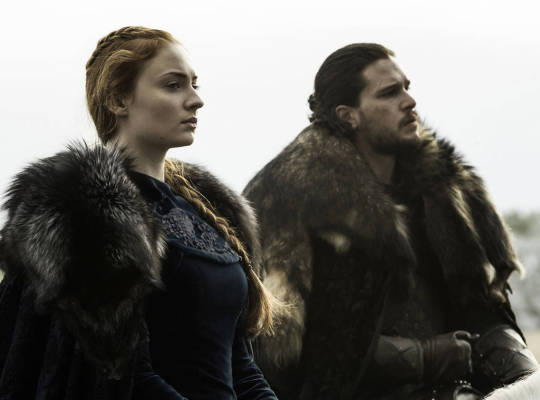
This is the fifth installment in my analysis of the romantic subtext in the scenes between Jon and Sansa in seasons 6 and 7 of Game of Thrones (Part 1, Part 2, Part 3, Part 4). I’ve examined the different techniques that the show employs to create this subtext through primarily visual means. This post is is a direct continuation of part 3 and part 4 where I began examining the romantic tropes that inform the scenes between their. Once again I’ve had to break up my analysis because there are so many tropes in play and I am trying to be meticulous in my analysis. So here is yet another very long post.
KNOW YOUR TROPES
The ambiguous romantic subtext in the scenes between Jon and Sansa exists almost entirely on the level of the visual - and that means that we have to pay close attention to non-verbal cues, costume design, image composition and editing.
I have previously mentioned that tropes are excellent tools when it comes to creating subtext because they function as a narrative shorthand. They rely on audience familiarity and genre conventions, which mean that there’s no need to spell things out - and subtext exists at the level of the unspoken.
So without further ado, let’s have a look as some more JonSa scenes where romantic tropes are in play.
Gentle readers, gird your loins - this post is hella long.
Declaration of Protection. This trope occurs when the hero’s motivation is built around protecting another person. This is usually the love interest but it can also pertain to other kinds of relationships (as well as larger entities such as a home or the realm as per Jon’s season 7 arc).
Both seasons 6 and 7 make it clear that Sansa is the hidden reason for many of Jon’s actions. She’s the one that gives him the will to live and fight again. She shakes him out of his depression and disillusionment after he’s been resurrected - and he is determined to protect her at any cost. The night before the Battle of the Bastards, Jon issues a solemn declaration of protection when Sansa states that she’ll never let Ramsay take her alive, hinting that she’ll kill herself if Jon loses the battle.
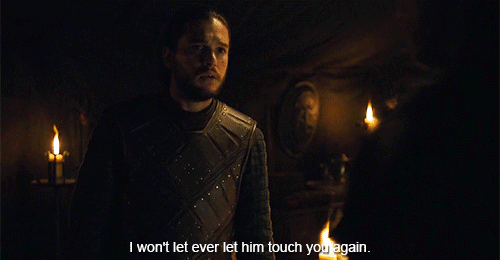

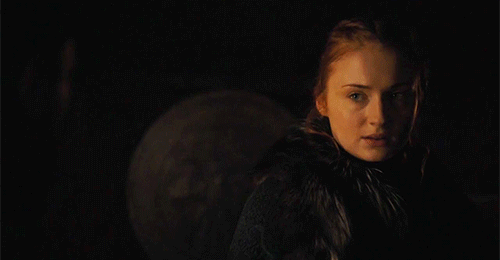
(GIFs by https://giffferrplanet.wordpress.com/2016/06/23/game-of-thrones-the-night-before-the-battle/)
Sansa’s reaction is heartbreaking. No one has be able to protect her since her father died and her scepticism in the face of Jon’s promise is understandable yet so very sad. However, the thing to notice here is Jon’s sad puppy-dog face when Sansa leaves - now it isn’t just Winterfell that hangs in the balance, Sansa’s very life rests on his shoulders as well.
Battle Couple. This trope pertains to a couple who are partners in combat:
This is the kind of couple where bullets figure prominently in the story of their romance. Where “war buddy” and “significant other” are synonyms. If you harm either one of them, the survivor will kill you as surely as the sun rises. (TVTropes)
Jon and Sansa may not fight side-by-side in the physical sense but Sansa’s presence at the parley with Ramsay (as well as her involvement with raising troops, etc) puts them into the territory of Battle Couple. Furthermore, the visuals repeatedly puts them side-by-side to emphasize them as a team.
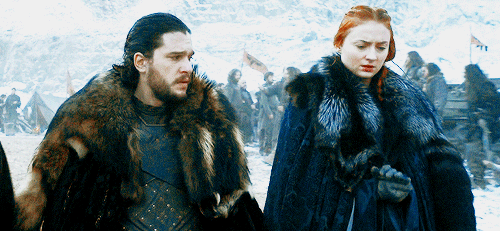
The parley with Ramsay offers a number of shots that presents Jon and Sansa as a united front.
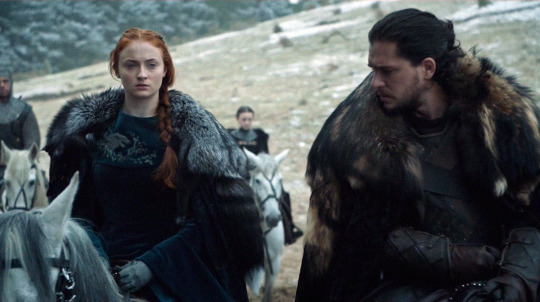

In short, they look “beautiful and majestic” together (as the script explicitly states).
Ruling Couple. This trope is generally used in relation to a monarchial setting:
A ruling couple, on the other hand, are equal or near equal partners, and may even be Happily Married. Rather then one ruling and one staying in the palace they jointly rule. The rulers will rely on each other as trusted counselors and they will be The Good King and The High Queen in one. Perhaps they will show this by receiving audiences on two thrones. Perhaps the consort will have a regular seat in the royal council and a vote. Perhaps even the two of them will discuss deep and labyrinthine affairs of state during matrimonial activities.
On many occasions, they will also be a Battle Couple. (TVTropes)
Jon and Sansa may not be a Ruling Couple in the traditional sense (not yet anyway). However, the visuals repeatedly show them sitting side-by-side, looking regal, when they interact with their bannermen.

The shot below is an especially strong visual because it offers a simple yet effective image composition. Jon and Sansa are placed firmly in the centre of the shot, framed by the large hearth that forms a pale background against which and they stand out visually. They are further framed by the black silhouette of the bannermen. This, along with the slow zoom in, serve to highlight them visually in a way that ruling couples often are presented. Once again, Jon and Sansa look beautiful and majestic together.
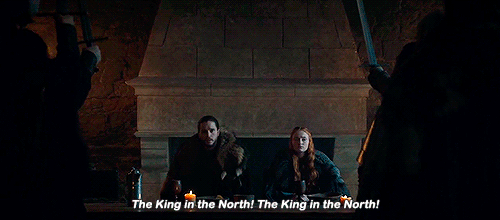
This shot is not only visually striking but it may very well be narratively significant as a piece of subtle foreshadowing. The kingmaking scene follows the most narratively important reveal in the entire show: the revelation of Jon’s true parentage as the son of Lyanna Stark and Rhaegar Targaryen. Immediately after this revelation, Jon is chosen as King in the North based on his status as Ned Stark’s bastard son and he’s thus elected under false pretenses even though he is unaware of his true parentage.
Placing the parentage reveal before the kingmaking is an interesting (and very deliberate) editing choice because it introduces the possibility that Jon’s parentage may become a problem for his kingship in the future. Jon’s true parentage relates to several popular tropes: Really Royalty Reveal, Hidden Back-up Prince, Secret Legacy - or as I like to call it: the Hidden Prince. When a narrative employs this trope, the truth will ALWAYS come out and it is always be of extreme narrative importance. While Jon relinquished his kingship in season 7, his status as a leader in the North may very well be further imperilled when the truth comes out. There’s been written several metas on how a marriage between Jon and Sansa would effectively unite the competing claims to North and unite House Stark firmly under Jon’s leadership, so I won’t go further into this argument here.
Rather, I’d just point out that by placing the parentage reveal right before a scene that invokes a visual iconography of a ruling couple in such a strong image composition, the show simultaneously teases the likelihood of a future conflict as well as its possible solution - in one single image!
When Jon is declared King in the North, despite Sansa having the heriditary claim to Winterfell, he turns to Sansa to gauge her reaction. he wants her to approval before he accepts the kingship - and she smilingly approves without uttering a single word. Yet another instance of them being in accord.

It is a move that is similar to this interaction between King Leonidas of Sparta and his queen Gorgo in 300 (2007) - spouses in accord, there’s no need for words.

Whilst Sansa isn’t Jon’s formal co-ruler, the show continues to seat her next to Jon when he exerts his authority as king. This is especially important since Winterfell’s Great Hall lacks the visual stage-setting of power that characterizes the Red Keep and Dragonstone. Jon’s “throne” is just a regular chair and he is placed on the same level as his subjects - yet he maintains a certain distance by standing behind a separate table at the end of the room, right in front of the visual centre provided by the hearth. The table acts as a physical and visual barrier between him and his bannermen so even though he’s not physically elevated above his vassals, he does inhabit a space that is sectioned off from them (though he quickly moves beyond it). Sansa inhabits this same space, right by his side!
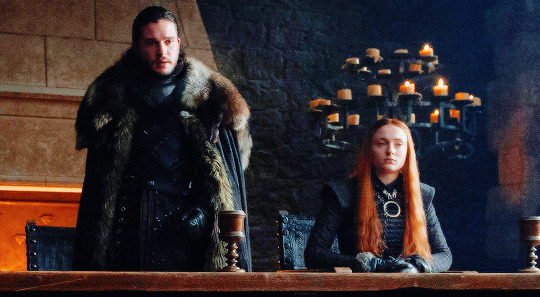
However, Davos also sits next to Jon, at the same side of the table. Here it is important to pay attention to the image composition! As you can see, Davos is seated a bit farther from Jon than Sansa - and this slight separation is visually emphasized by the hearth where the light reflected on the lower mantel creates a visual barrier between Jon and Davos. No such barrier exist between Jon and Sansa - and the slightly skewed perspective also makes them look closer to each other. In short, though three persons are seated side by side, Jon and Sansa are grouped together in a visually distinct manner that evokes the iconography of a Ruling Couple.
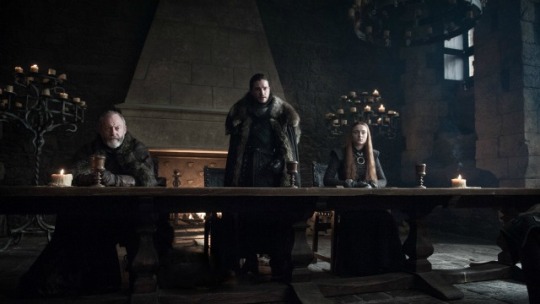
Even their costumes support this trope! @jonsalways has penned an amazing costume meta that about Jon and Sansa’s costumes in seasons 6 and 7. She notes that the colours and the overall silhouettes of their costumes match each other, which not only makes them look good together but also serve to underscore them as a team. I’m going to quote her here because she cuts to the heart of the matter in such a succinct manner:
When you look at the items they wear (it) is also wonderful. They both have a cloak, a cape, a dress/shirt, a “metal necklace”, a collar over the necklace and a belt. Every single detail in Jon’s costume has a equivalent on Sansa’s. It’s almost as they wear the female and male version of the same outfit.

When they are side by side, they look beautiful because their costumes match in pieces and their silhouette look just right. It’s comfortable to look at them because they look so similar. It’s almost like you don’t see two characters wearing two different concepts. You see them together as one whole concept. If they could switch their cloaks/capes, the colors would work just fine. And they are the only Starks whose costumes do that. Michele Clapton does it for a reason.
The elements mentioned in the quotes work on the level of the visual sub-conscious, i.e. we simply notice that they look aesthetically pleasing together but it is seldom something that the general audience give much thought to.
However, there are obvious symbolic elements to their costumes that we are most definitely are meant to notice; elements that also work as statements about their characters and their narrative journeys. In the case of Jon and Sansa, the symbolic element is the Stark direwolf, the heraldic sigil of their House - and this element tells the story of two characters travelling towards the same destination in season 6 and on parallel lines in season 7.
In season 6, we see Sansa visually reclaim her identity as a Stark through an act of (literal) self-fashioning: she makes a beautiful dress where the bodice acts as the canvas for the presentation of the Stark direwolf, made with materials that probably are supposed to evoke the natural landscape of the North - such a irregularly cut squares of mother-of-pearl (that made me remember the wonderful mussel shell necklace that Karsi wore in season 5).
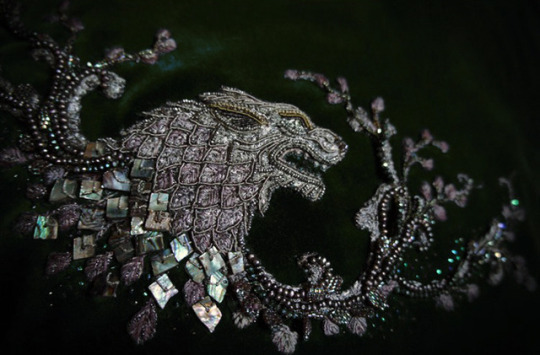
Sansa’s homemade dress is a profound act of self-reclamation. She emblazons her chest with the ancestral symbol of her family - almost as an answer to the way the Lannisters put their heraldic stamp on her neck in season 3:

Throughout the season she’s repeatedly insulted as being no Stark - Lord Glover tells her House Stark is dead and Lady Mormont snidely calls her both a Lannister and a Bolton. Sansa answers that she will always be a Stark - and it is written on her body for all to see.
Jon is also wearing a single direwolf on his costume to match Sansa. However, his symbol is much more discrete in form and placement - probably both for reasons practical and symbolic. Sansa is the trueborn Stark after all. Jon’s cloak is a gift from Sansa, she made it herself - and the show actually takes the time to show us this:
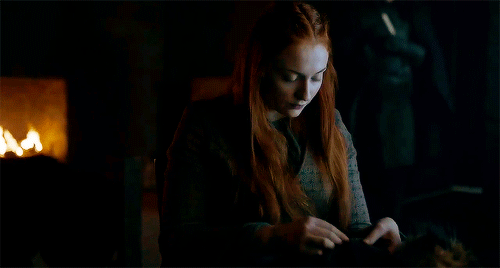
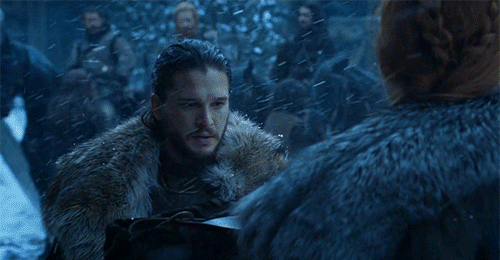
We don’t see Sansa make the dress that is so important to her identity - but we get to witness her make a garment for Jon that is invested with a profound emotional, symbolic and political value. When Sansa gifts Jon with a cloak stamped with the Stark direwolf she wordlessly acknowledges and claims him as a Stark for all the world to see - the very thing that always has been Jon’s greatest wish! It is really very beautiful - she’s the one that makes a matching pair out of them (since she probably also made her own Stark fur).
Politically, Jon’s new cloak is also significant - not just because of the Stark sigil but also because it is just like the one Eddard Stark wore! The patriarch whom the North once were sworn to, for whom they went to war! It is a politically savy move because Sansa Stark understands that clothing isn’t just about covering your body, it is also a language.
(the two edits below are by @baelerion)

Season 7 builds on this symbolic aspect of Jon and Sansa’s costumes. Now they both wear a pair of direwolves facing each other. Notice how they wear the Stark sigil on the same part of their bodies in both seasons - on the chest and then at the neck! Once again they match.
The double direwolves are interesting because, unlike season 6, their stories have moved beyond becoming Starks (again). Now their narrative journey is about their partnership and that is signalled by the double direwolves. They have to learn to act in tandem. While they have their differences and instances of miscommunication, season 7 is about them acting as a ruling team, as King in the North and Lady of Winterfell - two titles that originally belonged to just one person. Once again they are being posited as two halves of a whole - the ruling pair of the North, which is formalized when Jon names Sansa his regent before he travels south.

Interestingly enough, Jon and Sansa’s double direwolves have their echoes in two earlier costumes. When Bran acted as Robb’s regent in season 2, he wore a gorget just like Jon’s - and when Robb attended the Red Wedding as KitN he wore a pair of direwolf clasps just like Sansa’s! Now the costumes are reversed, the gorget for the KitN and the clasps for his regent. An interesting detail that very likely is significant, considering Michele Clapton’s symbolic and narrative approach to the costumes of GoT.

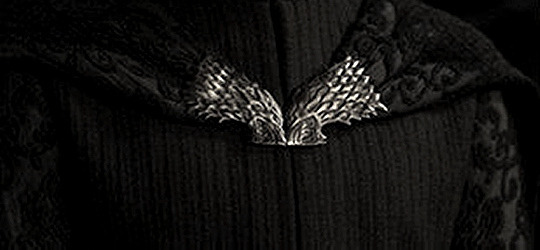
Even down to the smallest detail, the costume design presents Jon and Sansa to the audience looking like a ruling couple; a couple that are on parallel narrative journeys. It is also worth noting that it is only Jon and Sansa who wear the Stark sigil in season 7! Neither Arya nor Bran appear to wear the Stark direwolf even after they’ve returned home to Winterfell. Perhaps that is because it is Jon and Sansa who are the leaders of House Stark and the North.
I’m going to return to the issue of image composition in relation to the Ruling Couple trope. When season 6 aired, HBO released this wonderful and very memorable photo. (I’ve reversed it for visual variety)

This beautiful image doesn’t actually match what we see on out TV screens! This is a still photograph, taken by a separate photographer (a unit still photographer). Not only do we not see this exact pose in the episode in question but it is also clear that this image has been through a graphics editor since the bluish tint from the episode has been removed in favour of a stronger visual contrast with the background so Jon and Sansa’s figures capture the eye immediately.
Still photographs like this are created specifically for publicity and marketing. This image became very popular with the media outlets that cover the show - not surprisingly since it is one of the most visually arresting images among the promotional material released to the press. This image became a very popular header picture in several reviews, think pieces and post-season articles, such as this one in TIME where a possible Jonsa marriage is discussed.
I hesitate to name this photo “iconic” because I think it is too early to use that designation. It is, however, an extremely striking image with the clear-cut profiles, the matching costumes and the sharp silhouettes against the light background - there’s no visual “clutter” to distract the eye from the regal couple. Jon and Sansa really stand out against the background and everything from the direction of their gazes to their matching colours and silhouettes tie them together visually as a couple. They look like a king and queen in this image and since it was a popular choice with the media outlets, it is an image that has repeatedly been presented to the people who follow the coverage of the show online. That kind of image repetition can also work to plant the idea of Jon and Sansa as a couple on the subconscious level.
This image is pretty much the incarnation of the line from the script about Jon and Sansa looking “beautiful and majestic”. They look like a King and Queen, there’s no need for crowns here.
No other couple has looked as regal as these two in the entire show!
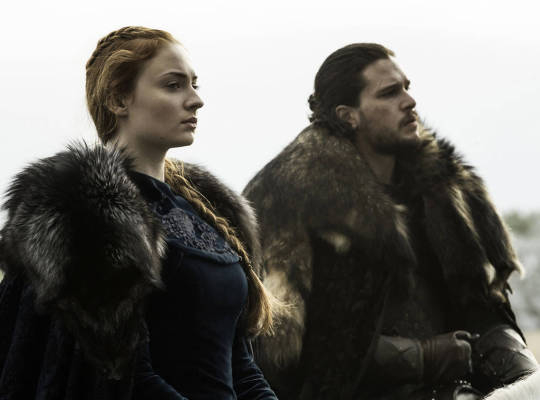
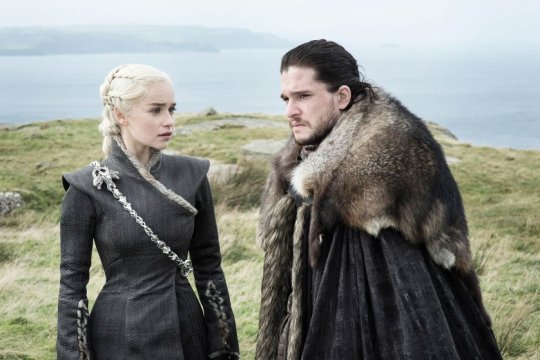
In contrast, one of the most popular stills of Jon and Dany from season 7 is markedly different. @jonsalways has noted how Jon and Dany’s costumes never truly match, neither in colour nor in silhouette. That also is very apparent in this image. What is even more interesting is the fact that this composition doesn’t convey harmony and togetherness like the regal image above, which makes sense since Jon and Dany isn’t one the same page in this season. Not only do they have conflicting interests and goals, the one is also intent on subjugating the other. In short, they don’t look like a romantic couple.
In terms of body language Jon and Dany are completely out of sync and there’s a distinct lack of communication between them. Whilst Dany is gazing at Jon, her body turned towards him, Jon’s attention is elsewhere. He faces away from her and doesn’t even seem to acknowledge her presence. When compared with the JonSa image above, the background almost feels visually “cluttered”, which also means that it is much less attention-grabbing than the first image. When it comes to drawing visual attention to something, less is generally more.
As said, the regal image of Jon and Sansa doesn’t appear in the show itself. The closest the show matches the promotional image is this double profile shot:

This shot is of particular interest in relation to the Ruling Couple trope because the image composition adhere to a common iconographic schema for portraits of royal couples.
Fx in this coin minted for the 70th wedding anniversary of Queen Elizabeth II and Prince Philip.

Or this design for a stamp featuring Crown Prince Frederik and Crown Princess Mary of Denmark. These are but a few example from a vast number of offical royal portraits.
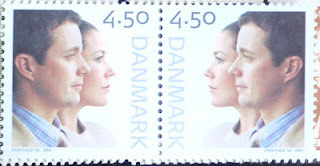
Throughout seasons 6 and 7, the show presents the audience with a large number of visuals that depict Jon and Sansa in a manner that is associated with ruling couples.
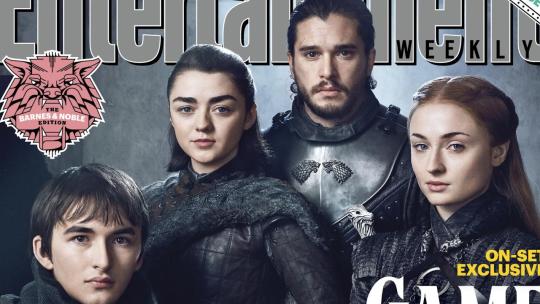
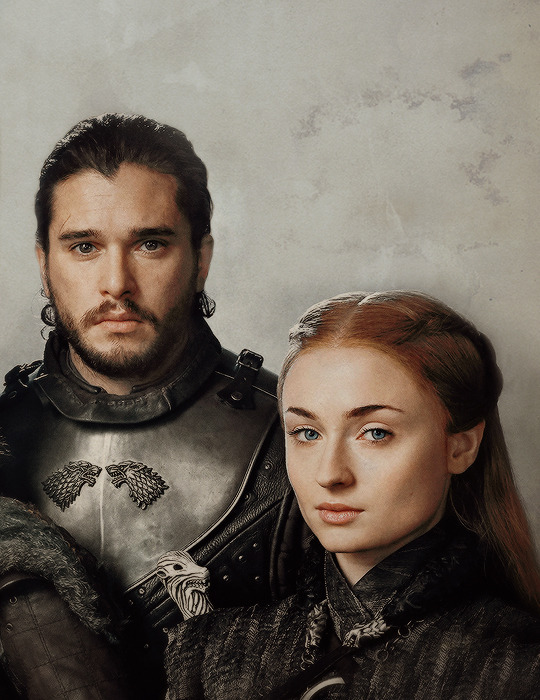
Interestingly enough, the Stark-centric cover of Entertainment Weekly in 2017 positively screams Northern Royal Family! This is of course a group portrait of a group of siblings (even though Jon is actually their cousin). However, not only is Sansa placed next to Jon (instead of fx between Bran and Arya), the combination of a standing male and a seated female evokes a time-honoured compositional template for official royal portraits. I’ve included a couple of examples for comparison.
Crown Princess Victoria and Prince Daniel of Sweden.
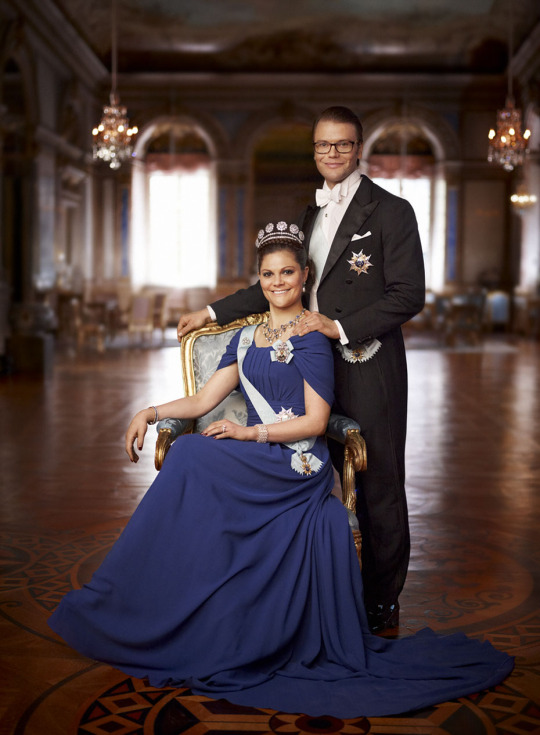
King Frederik IX and Queen Ingrid of Denmark.
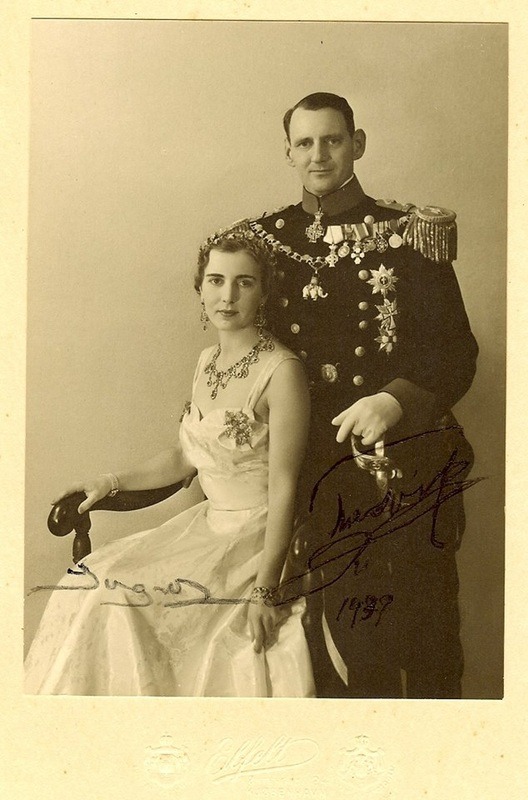
Then there’s this lovely portrait of Crown Prince Frederik and Crown Princess Mary of Denmark.

This is a slightly different variation on the pose but it is also a popular one in royal portraiture. Notice how we also have a very similar image of Jon and Sansa in the last episode of season 6?
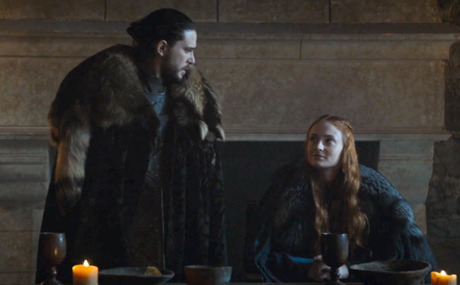
It is unclear whether the cinematographer consciously chose to model these shots of Jon and Sansa on popular visual conventions for royal portraiture. It is entirely possible that these similarities are coincidental to a certain degree. By that I mean that when we see a lot of pictures, certain types of composition becomes so familiar to us that we don’t register them consciously. However, I do think that the similarities between the image composition in the shots where Jon and Sansa are placed side-by-side are the result of some conscious choices, especially since directors and cinematographers often turn to art for inspiration (like Dan Sackheim took inspiration from Caravaggio’s art for Jon’s resurrection scene).
To be continued...
(GIFs and edits not mine)
260 notes
·
View notes
Text
A Severance Negotiation Success Story: An Inside Look At How One Man Negotiated His Freedom
The following is a guest post by Steve, a reader and a consulting client who is currently traveling the world with his family after a 20 year career in mass media. So many times we’re just too paralyzed to make a change because we just can’t see a path forward. It’s these stories that keep me so motivated!
As I write this, I’m sitting on a balcony sheltered by lush tropical leaves. I close my eyes to savor a gentle breeze that has just kicked up, caressing the trees and taking the sting out of another cloudless 95-degree day. I flick over to the Times to check out the latest on a monster winter storm that is shutting down the East Coast. Hmmm, maybe I should extend my time in Costa Rica to a third month.
Just a few months ago, I was one of those East Coast worker bees bracing for another winter of long commutes and office frustrations. But then something wonderful happened — I lost my job. Not in a careless or unfortunate way, but as the result of a deliberate, carefully considered strategy that took months to bear fruit in the shape of a six-figure redundancy package.
Two months on — as I spend my days here doing little more than reading, learning to surf, and exploring rock pools with my four-year-old daughter — I still have to pinch myself every time I see that another full paycheck has thumped into my bank account. And it horrifies me to think that I was on the verge of simply quitting.
My achievement owes a lot to Sam through his book How To Engineer Your Layoff and a subsequent phone session of one-on-one coaching. He suggested I write an account of how I did it – not to plug his services, but as a reminder to all you financially astute FS readers that you should NEVER, EVER quit a job and always try to negotiate a redundancy package, no matter how far-fetched it may seem to you.
My Why
It certainly seemed unlikely to me. Before I get into the nitty-gritty of how I did it, here’s a little background on my circumstances. I had been with my employer for close to 20 years, and overall it had been a very happy relationship. The job was high-profile, frequently stimulating and rewarding, and in a field of work that I loved and respected. It took me around the world, and the benefits were pretty good – by the end I had five weeks’ paid vacation a year, a salary north of $150,000, and was established as a senior employee whose work was highly valued.
But, increasingly, I couldn’t escape the reality that it just wasn’t capturing my imagination or making me as happy as it did in my 20s and 30s. In recent years I started to resent being tied to a desk in stuffy offices, ever more conscious that my time on this planet was finite and thus increasingly valuable — a feeling that was magnified by the birth of my daughter. Sam’s post on freedom vs. wealth sums up this tension that I and many others feel as we look to the second half of our lives.
I was harboring ambitions to take back control of my time and go freelance, even though I knew that – at least initially – I would probably only make about half my current salary and would lose valuable benefits like healthcare and 401k contributions. I seriously considered quitting but that seemed wasteful after putting in two decades of work, not to mention risky.
I knew that my employer – a big, multinational company – did periodically give out redundancy packages. Every 5-10 years there would be a big purge of employees when the company was going through a tough time or a restructuring. But in normal times, they were usually only offered to “underperformers” – a category that I was not in, despite my waning enthusiam for the work.
What I needed was the confidence to broach the subject with my managers and the know-how to make the most of any opportunity for a lay-off that emerged. Enter Sam. After devouring his book and having an hour-long follow-up with him, I finally had the confidence and a clear strategy.
Here’s How It Played Out
– First, I reached out to a few former colleagues who I knew had got redundancy deals to get a feel for how the process had worked for them. This gave me some insights into what was possible. A conversation I had with a former manager who himself had overseen many redundancies was particularly valuable, as he gave me the tip that there was usually some money left over at the end of the year to pay for packages.
– I had an initial conversation with a manager – not my immediate boss but someone who I knew was a bridge between HR and upper management and with whom I was on friendly terms. I immediately played my main card — that I wanted to have time off to spend time with a close relative who was in failing health. I asked this in an open, curious way, seeking to draw out what my options could be from the company’s point of view. A months-long leave of absence or working remotely were the main options we discussed. But since the conversation was going well, I decided to bring up redundancy at the end as an outcome that I could be “open to.” I put forth one idea for how that could benefit the company, by allowing them to move my headcount to a higher-priority business area. We agreed to talk again after she had discussed it with the higher ups.
– When we reconvened a week or so later, she laid out the options: the company was open to giving me a leave of absence of up to three months or to allow me to work remotely, but redundancy was off the table as that was usually reserved for underperformers and they “didn’t want to lose me.” I hid my disappointment and said I’d consider the other options.
– A month later, I’d heard nothing more and was becoming resigned to the failure of my plot. How stupid of me to have thought anyone would hand me a small fortune to walk away! Then, out of the blue, my contact called me into a conference room. “Would you still be interested in that third option we discussed?” she asked. “Umm, yeah I think so,” I replied, struggling to hide my excitement.
– The rest was pretty easy. I talked through the package with the head of HR – it was a standard, but relatively generous deal that gave me nearly a year’s salary plus continued healthcare for the whole period. Before I knew it I was heading for my farewell drinks, feeling very bitter-sweet about leaving great colleagues and an employer that I still felt a lot of loyalty toward.
Keys To Swinging A Severance Package
Based on my experience, here are some of the keys to swinging a redundancy package. Sam goes into these points – and many more – in much greater detail in his book.
Confidence. The first step is to really believe it’s possible. I really struggled to believe my company would do this for me and had long worried that it might adversely affect my standing with management if I tried and failed. But the truth is that in most cases you really have nothing to lose, and the chances of getting a deal are probably higher than you think once you start planting seeds of doubt in management’s mind about your commitment to the job.
It’s not personal. Again, this was a blockage for me. I’d been with my company for such a long time and generally been treated so well that it felt almost like an act of betrayal to angle for a “golden parachute” while I was still in my prime working years. Despite that emotional attachment, the cold truth is that my company – like all others – is overwhelmingly concerned with the bottom line and its reputation. It wouldn’t have hesitated to kick me to the curb in an instant if either of those were under threat. Also bear in mind that companies, especially larger ones, have a keen interest in making sure that employees leave on good terms and don’t start griping about its problems on social media or in the press. In the end, my departure was a win-win for my employer and me because it helped the company meet a budget and personnel goal without having to force redundancy on someone else.
Leverage the law, but don’t push it. By international standards, the U.S. is a very employer-friendly place when it comes to workers’ rights. But there are still some effective legal buttons that the canny redundancy seeker can push. In my negotiations, I steered clear of raising my right to family-related unpaid leave to avoid coming across as antagonistic. Just hinting that I knew my rights and being inquisitive about a leave of absence was enough. Few employers really like letting a worker take a prolonged leave as it tends to throw their plans into uncertainty.
Have a solid post-redundancy plan in place. Leaving a long-term job can be disorientating, even if it’s done on your own initiative. Taking a big vacation is, quite rightly, the first thing on many people’s mind. There are few things better – as I can now attest – than being paid to play on a gorgeous beach for weeks on end. But my experience is that after a while vacations can start to feel like work, especially when caring for a 4-year old is part of the package. And it isn’t long before some anxiety starts to creep in about the income cliff you are facing at the end of the redundancy period.
That’s why it’s important to have thought past your well-deserved break to your next move from a professional and financial perspective. In my case, I had amassed a solid amount of savings and established a passive income stream of over $35,000 a year (nearly half of my annual expenses), which gave me confidence that even in a worst-case scenario my family and I wouldn’t end up on the streets.
I’d also sounded out several contacts about freelance work, giving me confidence that I could at least get paid enough on a part-time basis to pay the bills. Between Costa Rica and Europe, I’m taking a three-month vacation — about a third of my total redundancy period — before returning home to seek new work prospects.
It’s early days and there are certainly some lingering fears I have about giving up a chunky salary and trying to reinvent myself. What if the stock market crashes and damages my nest egg? What if my family healthcare costs shoot up? What if my skills are not as marketable as I hope? But I firmly believe that our fears about financial failure tend to be overblown. Hell, if it comes to it I can always drive an Uber — or just move to Costa Rica!
We plan to work on trimming our expenses over the next year and investing more in real estate platforms to further narrow the income gap. If I can make just half my previous income and gain the flexibility to spend more time with family and friends by working remotely, I will consider the redundancy move a roaring success.
– Steve
from http://www.financialsamurai.com/a-severance-negotiation-success-story/
0 notes